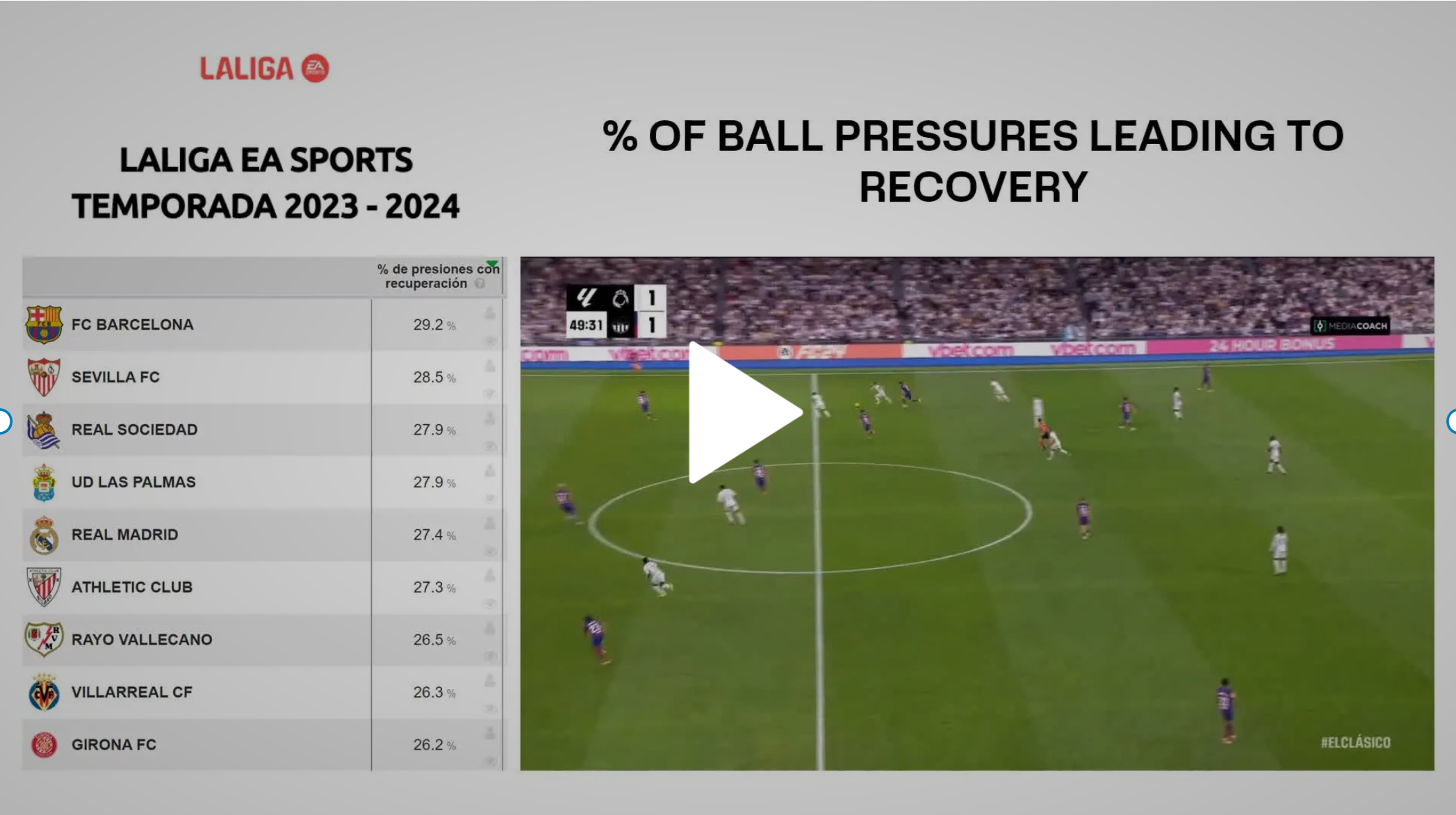
04 Jul Analyzing the Impact of Pressing Metrics on Match Outcomes in LaLiga EA Sports Season 23/24
Abstract
This study examines the relationship between various pressing metrics and match outcomes in the LaLiga EA Sports Season 23/24. We focus on pressures on the ball holder, high and low-intensity pressures, and the percentage of pressures resulting in recovery. Our findings indicate statistically significant differences in these metrics based on match results (Win, Draw, Loss). Notably, the effectiveness of pressures, rather than their quantity, plays a critical role in determining match outcomes.
Introduction
In modern football, pressing has become a key tactical element, influencing both defensive solidity and offensive transitions. While the intuition might suggest that more pressing leads to better results, this study aims to dissect the nuances of pressing effectiveness and its impact on match outcomes in LaLiga EA Sports Season 23/24.
Methods
Data was collected for all matches in the LaLiga EA Sports Season 23/24. Each row in the dataset represents a team’s performance in a match, including pressing metrics and match outcomes. We employed Analysis of Variance (ANOVA) to assess differences in pressing metrics across three result categories: Win, Draw, and Loss. Metrics analyzed include pressures on the ball holder, high-intensity pressures, low-intensity pressures, and the percentage of pressures resulting in recovery.
Results
Pressures on the Ball Holder
- F-statistic: 6.664
- p-value: 0.0014
- Teams that lost matches exhibited significantly higher pressures on the ball holder compared to teams that won or drew. This finding suggests that a higher volume of pressing is often a reactive strategy rather than a proactive one.
High-Intensity Pressures
- F-statistic: 7.788
- p-value: 0.0004
- High-intensity pressures were more frequent among teams that lost, indicating an urgent and aggressive pressing style when trailing.
Low-Intensity Pressures
- F-statistic: 8.804
- p-value: 0.0002
- Similar to high-intensity pressures, low-intensity pressures were more common in losing teams, reflecting a broad spectrum of pressing strategies employed in an attempt to regain control of the match.
Percentage of Pressures with Recovery
- F-statistic: 3.845
- p-value: 0.0218
- Winning teams showed a significantly higher percentage of pressures resulting in recovery. This metric highlights the importance of not just the volume but the effectiveness of pressing actions.
Discussion
The analysis reveals that pressing more does not inherently lead to better match outcomes. Instead, the effectiveness of pressing—measured by the percentage of pressures that lead to ball recovery—is a more crucial determinant of success. Teams that win matches tend to press less frequently but more effectively, recovering the ball at higher rates. This efficiency in pressing allows for better defensive stability and more opportunities for successful transitions.
The data also suggests that teams trailing in matches tend to increase their pressing efforts, both in high and low intensity, as a reactive measure. However, this increased pressing volume does not translate into better outcomes, possibly due to lower effectiveness and higher physical and tactical costs.
Conclusion
Our findings underscore the importance of pressing effectiveness over sheer volume. Coaches and analysts should focus on optimizing pressing strategies to enhance recovery rates rather than merely increasing the number of pressing actions. This approach can lead to more stable defensive performance and more potent offensive opportunities, ultimately improving match outcomes.
Implications for Practice
- Training Focus: Emphasize drills and strategies that improve the effectiveness of pressing rather than the frequency.
- Match Analysis: Incorporate pressing effectiveness metrics into post-match analyses to identify areas for tactical adjustments.
- Tactical Adjustments: Adjust pressing intensity based on match context and opponent behavior to maximize recovery rates.
Future Research
Further research could explore the longitudinal impact of pressing strategies across multiple seasons and leagues, as well as the interplay between pressing effectiveness and other tactical elements such as counter-pressing and positional play.


